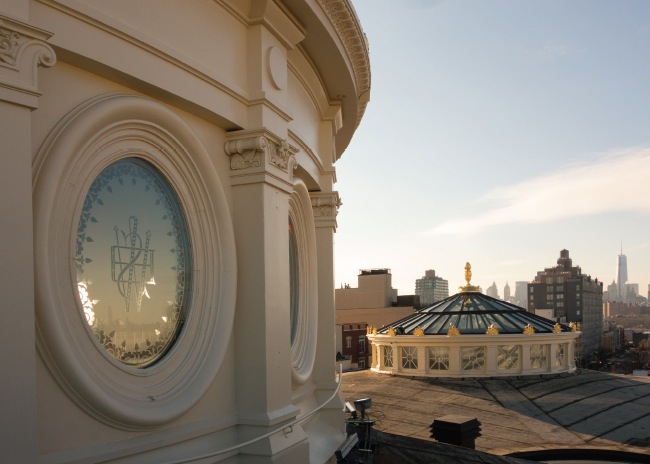
photos by Durston Saylor / The main dome has a ring of 20 oval windows; the bank’s initials are etched into the glass.
In the distance is the second dome with a stained glass skylight.
By Mary Yeung
“This is my life’s work,” says Carlos Perez San Martin, general manager and part owner of Weylin B. Seymour wedding venue. Perez San Martin is only 32 years old, but he is old enough to know that the opportunity to restore and manage a beloved national landmark like the Williamsburgh Savings Bank building comes only once in a lifetime.
The Williamsburgh Savings Bank is not just another beautiful building, it’s architectural opera, complete with history, passion, beauty, politics, community, and a parking war. It’s La Bohème, Les Miserables, and The Marriage of Figaro all swirling inside that indomitable cast iron dome like a mini tornado.
We are gazing up at the magnificent cast iron dome, soaring high above the 110-foot ceiling. Twenty oval windows encircle the dome, with natural light pouring in from each porthole, shafts of light crisscrossing beneath the celestial blue dome. To pronounce the sight awe-inspiring is an understatement. You can clearly see the sinuous WSB insignia etched on each windowpane. WSB once stood for the Williamsburgh Savings Bank; now it stands for Weylin B. Seymour.
Weylin who? That was my initial reaction, too. So I Googled him. Exactly one wiki page on “the man” came up; the rest of the listings were for the domed building at 175 Broadway. According to the wiki page, WBS was a local barber who turned to matchmaking, became a wedding planner, and grew into a millionaire whose dying wish was for Williamsburg to have its own spectacular wedding venue that would rival any party space in Manhattan. The New York Times called him a fabricated character. Perez San Martin sheepishly admits the name was “discovered” by his graphic designer Federico Rozo. Management was worried that the Williamsburgh Savings Bank didn’t sound romantic enough for a wedding venue; after all, who wants to get married in a bank (maybe rich people?)? So they came up with this character, whose initials, WBS, match the fancy WSB initials that were stamped, carved, and etched on everything in the building: windowpanes, brass door knobs, bronze door hinges… Since the building is landmarked inside and out, you sort of have to go with it.
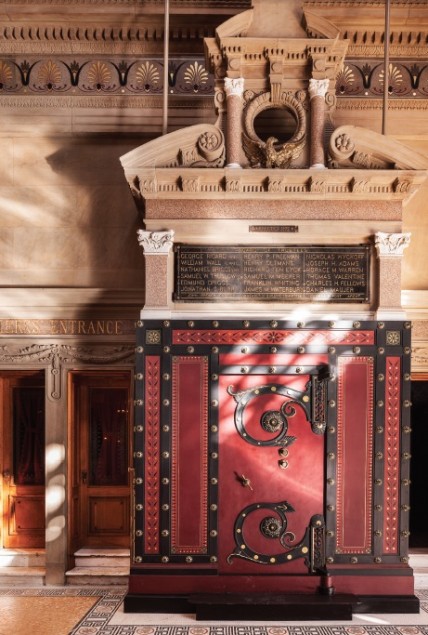
The imposing vault was imported from France in the 17th century.
Wacky marketing scheme or not, the building has been beautifully restored to its former glory by a team of consultants and artisans. “The result has exceeded all our expectations,” says Perez San Martin. The Beaux-Arts edifice was purchased by his cousin, the owner of Bushwick’s New York Loft Hostel and real estate developer Juan Figueroa, for $4.5 million back in 2010, when it was owned by HSBC Bank. Back then, his plan was to do a quick fix up and then rent it out as a cool party space. He hired his young cousin from Argentina to manage the project. In an interview given to Archpaper.com in 2011, Perez San Martin gave the figure of $1.5 to $2 million for the renovation, and he predicted that the place would be ready for event rentals in two years. Today, the budget for the restoration has exceeded $20 million, and, so far, it has taken three-and-a-half years. Even with generous federal and state income tax breaks, given because the building waslisted on the National Register of Historic Places, the costs are staggering.
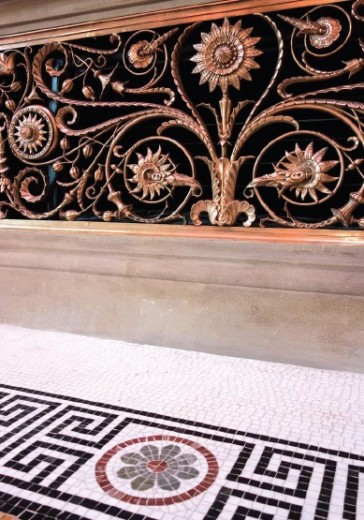
The floors in the hallways are paved with encaustic tiles from England.
“We fell in love with the building’s aesthetics,” Perez San Martin explains. “When we removed the sheetrock and peeled back the paint, we realized we had something truly beautiful.” He credits Figueroa as the spiritual aesthetics leader of the refurbished space. “Every time we found a mural behind the white paint, Juan always insisted on restoring it, or, if too damaged, replicating it.” Note: Figueroa has since sold his share of the business.
They put together an investment group and hired a team of twenty consultants and about a hundred and fifty artisans and technicians to tackle the job. “It was an international effort. We had experts from Germany; we ordered Siena marble from Italy, then sent it to Lebanon to be cut and assembled. We hired Mexican artisans.” The team worked under the leadership of architect and period expert David Scott Parker.
The Williamsburgh Savings Bank was designed by George B. Post, a student of Richard Morris Hunt, the architect who was known as the face of classical New York. They both worked during the Gilded Age, designing commercial buildings and private homes that were breathtaking in their grandeur. The WSB took five years to complete (1870 to 1875). The interior was designed by Peter B. Wight, a celebrated architect and interior designer. It was considered one of the most beautiful and avant-garde edifices in America at the time. And it was the first bank built to serve tradesmen and women, whose small deposits were not welcome at commercial banks.
In the words of the first bank president, Samuel Meeker, the Williamsburgh Savings Bank was established to “afford a safe and beneficial place to deposit for savings of tradesmen, mechanics, clerks, apprentices, laborers, married or single women and others.”
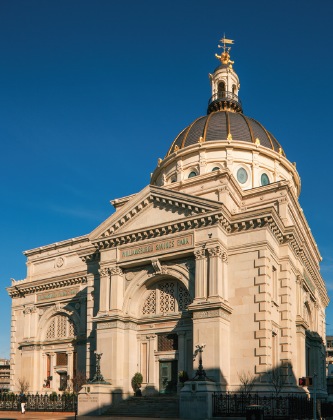
The bank’s landmarked Beaux-Arts exterior, designed by George B. Post in 1870.
As the Gilded Age faded into history, so did interest in the upkeep of these fancy buildings. The awe-inspiring dome was sealed in the 1940s, blocking out all those shafts of heavenly light. In the intervening years, when different banks took over the building, they boarded up different sections and whitewashed the murals, while doing their banking in smaller designated areas.
In 1966, the WSB’s exterior was granted landmark status, saving it from the tragic fate of Pennsylvania Station. Republic Bank took over in a bank merger in 1993 and commissioned the architectural firm of Platt & Byard Architects to draw up restoration plans for the building. By 1996, the first phase of the restoration was complete, and the bank’s interior was granted landmark status. The same year, the bank was sold to HSBC, and the restoration stalled.
When Figueroa acquired it in 2010, much of the building was once again hidden behind sheetrock and white paint. As workers peeled back the paint, Figueroa and Perez San Martin realized that most of the opulent mid-19th century decoration underneath was still very much intact and deserved to be fully restored.
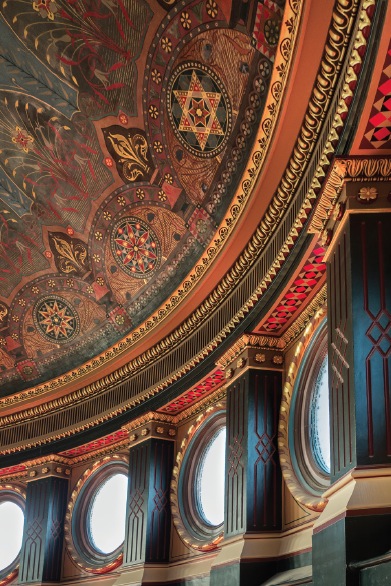
The main dome features the last surviving mural by Peter B. Wight.
Wight’s complex polychromatic murals, incorporating a mixture of Renaissance and French Neo-Grec motifs, were meticulously cleaned and restored by Sandra Spannan of see.Painting, Inc. Paint chips from the artworks were sent to labs so the colors and textures could be replicated. The wallpaper, designed by Wight for smaller meeting rooms and restrooms, was replicated or adapted by Federico Rozo and the San Francisco firm of Bradbury and Bradbury, specialists in period wallpapers. “Stephen Bauer, president and lead designer for Bradbury and Bradbury, flew in to survey the building and made recommendations for each room,” says Perez San Martin. Doorknobs and door hinges were recast in India. No expense was spared on gold leaf for every decorative detail. They kept the elaborate 17th century vault door that was imported from France and refurbished and reactivated the antique Otis birdcage elevator, one of only three unaltered originals still in existence in New York City. There are miles of new radiant heating pipes installed underneath the floorboards. Perez San Martin says the working relationship with the restoration crew went very smoothly. “Everybody believes he or she was doing something important. They all wanted to be here,” he says. Already, the WSB has received several restoration awards, among them, the Lucy G. Moses Preservation Award and the New York State Historic Preservation Award. Hollywood has also come calling: Keanu Reeves recently filmed a movie scene there.
The opening of Weylin B. Seymour’s Wedding Hall should be a great event for Williamsburg. For the past fifteen years, the neighborhood has had many crude modern buildings thrust upon it. Many new condos feature a 1970s pop-colored glass that looks like cheap plastic paneling. Sadly, these buildings are rapidly defining the look of Williamsburg. Not only do these structures lack a sense of grandeur, they don’t even have charm. And charm doesn’t cost much; all it takes is an architect with a little imagination and a developer who marginally cares about people. Often, it’s the fate of a hot new neighborhood in a shaky economy to attract developers who want to turn a quick profit. They throw up something fast and cheap, charge luxury prices for the area’s cool vibe, and move on to the next hot spot. Meanwhile, the locals have to live with these soulless buildings for years to come. For that reason alone, the new WBS / WSB should be celebrated.
Unfortunately, Perez San Martin is not feeling a whole lot of love from Community Board 1. The Board won’t approve his application for an in-house liquor license. “They feel that the catering companies have their own liquor licenses, so the venue doesn’t need one,” he explains.
The upkeep of a space like WBS is expensive, and without an in-house liquor license it will take awhile before the investors can recoup their millions. Perez San Martin insists that his company has given much to the community. It has created jobs for two hundred people for three-and-a-half years and will continue to generate many jobs with the party space. He points out that Juan Figueroa’s non-profit company maintains the public plaza on Broadway and Bedford Avenue, free of charge.
From the Community Board’s point of view, a 6,500-square-foot venue with a capacity of over five hundred patrons eats up a lot of parking space.
So far he has secured about 180 parking spaces; some spots are under the bridge, and some are in a garage just a few blocks away. There is valet parking for events, so patrons won’t have to drive aimlessly looking for parking. Currently, he is pursuing a venue liquor license with the State Liquor Authority, the final arbiter on the matter. The venue officially opened on January 4, 2014, for a wedding of the beautiful daughter of a late Kings World (TV) executive and a Presbyterian minister. Perez San Martin says everything went well; not too many glitches—except maybe the hefty utility bill. “We opened during one of the worst blizzards in New York,” he says.
I ask him about the party he threw to celebrate the completion of the renovation.
“Party? What party?” He shrugs.
“Well, are you planning to throw a party and invite everyone—politicians, movie stars, local journalists?”
Perez San Martin sighs and just shakes his head. “A party like that can cost, like, $50,000.”
At that point, I almost felt sorry for the guy. I mean, I know his family is rich and everything (“my family in Argentina has a business that employs a thousand workers…”), but it is a daunting responsibility for anyone to assume the operation of a building like this—the hefty payroll, interest on the bank loan, government bureaucracy, bridezilla wedding parties, utility bills, pesky journalists… I wanted to tell him, don’t worry about the cost, Carlos, just throw a potluck dinner. Marty Markowitz can bring the cheesecake, Bloomberg can order up a tub of caviar and some fancy imported crackers, DeBlasio can bring the pizza and some knives and forks, Eric Adams can bring some jelly donuts, Diana Reyna can bring a lovely avocado salad, Joe Lentol can order up a tray of veal rollatini from his favorite restaurant, Antonio Reynoso can bring some made-in-Bushwick something… Just take a day off and celebrate your accomplishments, for Christ’s sake…
I try to cheer him up with “So, when can the public check out the fancy digs? Are you going to offer architectural tours?”
“The Public? Tours?” There was a quick flash of terror in his eyes as if to say “hordes of people and fancy wallpaper don’t mix!” But he made a fast recovery and patiently explains: “This is a private events venue.”
I ask him about the rental rate for the domed ballroom.
“It’s expensive, very, very expensive,” he says.
In another words…if you have to ask…
For some residents, the reopening of the Williamsburgh Saving Bank building is a bitter-sweet experience. We’re all grateful that the new owners are not reincarnating the place into yet another boring, sheet-rocked bank, or worse, a CVS, like so many landmarked beauties throughout Manhattan.
On the other hand, it also signals the completion of Williamsburg’s gentrification. A palace created in the Gilded Age for blue-collar workers and women is now a private party space for the rich.
_______________
The City’s Proud Architectural History
George B. Post is often heralded for his design of the New York Stock Exchange, but his true masterpiece was the City College of New York, built with Manhattan’s unearthed bedrock at the turn of the century to educate the sons and daughters of Irish, Italian, and Jewish immigrants along with countless working class New Yorkers who came later. It was the free academy with an imposing Gothic Hall (adorned with 600 grotesques) as grand as any Ivy League tower. Peter B. Wight, Jonas Salk (cure for polio), Colin Powell, A.M. Rosenthal (former editor of the New York Times), Henry Kissinger, Daniel Patrick Moynihan, Stanley Kubrick, Alfred Stieglitz, Oscar Hijuelos, and most fantastically, Don Draper (the fictional character from Mad Men) are among its alumni. Post’s mentor, Richard William Hunt, who designed numerous mansions for captains of industy, including the Biltmore Estate in Asheville, North Carolina, also built the base for the Statue of Liberty and a charity hospital for the Association for the Relief of Respectable Indigent Females in 1883. Ironically, this is the only Richard Morris Hunt building left standing in New York City (it’s now known as the Hostelling International at 891 Amsterdam Avenue). These buildings, along with the Williamsburgh Savings Bank, are our national heritage, a poignant reminder that once upon a time in America, starchitects took time out to design and build exquisite buildings for humble folks.
________________
Leave a Reply